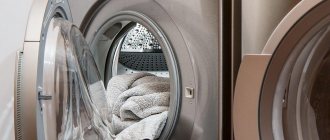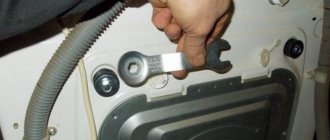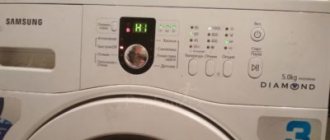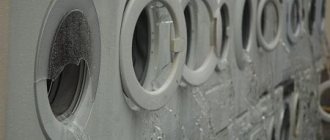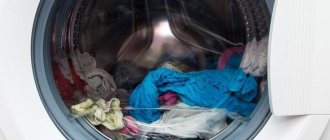When purchasing a washing machine (hereinafter also referred to as SM, ASM), most people expect that the unit will operate quietly. However, this does not always happen, and the owners do not know what is happening - maybe the machine is supposed to work this way. In fact, the washing machine makes noise during the spin cycle for several reasons.
Noise during operation of the washing machine causes a lot of trouble for owners
Small object or foreign part
The washing machine hums and whistles during the spin cycle due to the fact that some small item has gotten into the space under the drum. Let's look at the main reasons why they get there:
- Clothes pockets are considered one of the main problems. Saving just a few minutes before washing, which you need to spend on double-checking, develops into a real disaster.
- Loading items with buttons, beads, accessories and bras comes with additional risks. Small items of clothing may come off during the main or spin cycle. Try to use laundry bags whenever possible.
- A child can quietly place a toy in the tank or something small in the powder tank.
Important : Always check your clothing pockets before washing.
In the long run, foreign parts can ruin the operation of the machine. To prevent this from happening, you need to extract the excess by following simple steps:
- Disconnect equipment from electricity.
- Remove the top and then the bottom walls.
- Find the heating element, disconnect it and unscrew it.
- Carefully remove all objects and debris from the hole.
- Assemble the car, performing the steps in reverse order.
Most models are equipped with a special sump with a debris filter. As a rule, it is located at the bottom of the front panel. In this case, it is enough to open the door and remove the dirty filter for cleaning. If the washing machine does not start spinning clothes silently, return to parsing.
Precautionary measures
In order for the machine to work for a long time, you must adhere to certain rules.
- You need to be vigilant and carefully inspect things for small parts that may come off during washing and get into the tank. It is better to put such things in a special laundry bag.
- Remove money and other small items from your pockets that could damage the machine during the washing process.
- Protect the heating element from scale that forms from hard running water. To do this, you need to use water softening and descaling products.
- It is necessary to move the washing machine at least once every six months and check the serviceability of the hoses, as well as flexible wiring and pipes for damage.
- Wash and clean the drawer for powder and rinse aid. If this is not done, hardened powder particles may accumulate in the machine, which will interfere with the normal operation of the equipment.
- After each wash, leave the powder container and the machine door open. This is necessary so that the internal parts of the washer dry thoroughly.
All these recommendations will help extend the life of the washing machine and protect it from frequent breakdowns and calls to service centers.
Some types of repairs can be carried out independently, but still, if the breakdown is serious, it is best to contact a service center and call a specialist to your home.
Bearings
One of the most common reasons why a washing machine is noisy during the spin cycle is problems with the bearings. The only element that protects them from water and air is a rubber seal. It is not surprising that over time, leaks occur on the part, and as a result of corrosion, the washing machine begins to whistle and make unpleasant sounds. Usually the oil seal lasts for 5-7 years of stable operation, after which it needs to be replaced.
To detect bearing failure, you need to manually rotate the tank. If you hear a crackling sound or feel play, it is necessary to urgently lubricate or replace the problem unit.
Important : bearing repair is a very labor-intensive process and requires compliance with all manufacturer’s recommendations. If you are not confident in your abilities, it is better to contact a specialist.
Step-by-step instructions for self-replacement:
- You need to start by removing the top and back covers, after draining the water and relieving the voltage from the device.
- Remove the powder dispenser and then carefully remove the control panel. Most often it is secured with simple latches or a few screws.
- Similar to clearing debris, remove the heating element, and then the pipes and counterweight.
- Dismantle the weights that are located below and above the tank to facilitate removal of the drum.
- Remove the belt from the drum and engine pulleys, and then unhook the part from the shock-absorbing springs.
- Carefully remove the assembly and unscrew the pulley to get to the bearing. This can be done using a hammer and a blunt chisel. It is worth noting that in some models you will have to disassemble the drum.
Important : use only lubricants recommended by the manufacturer.
The replacement process is quite simple. It is necessary to remove old parts from the sockets, and then clean the metal rings from dirt. The next step is to install the new parts in place and apply lubricant. A thin layer is sufficient for the seal, but the bearings must be thoroughly treated.
Assemble both the bearings and the seal correctly. The latter, if installed incorrectly, will begin to let air and moisture through again.
Tips and tricks to avoid this problem
When choosing spare parts, it is best to purchase original ones, since they may differ in size. In addition, non-original parts may be of lower quality.
This video explains in detail the causes of noise and methods for repairing a washing machine.
By following simple tips, you can fix the problem yourself, but if you don’t know how to repair washing machines, then it’s best to contact a specialized service center (in addition, the warranty on the device is often quite long, 2-5 years). Otherwise, you can make the situation even worse.
Bolts for transporting the tank
To deliver equipment from production to your apartment in good condition, special fasteners and packaging are used. But with a washing machine everything is more complicated, since it consists of many moving parts. Manufacturers install shipping bolts that secure shock absorber springs.
Since the bolts secure the tank in a stationary state, it is strictly forbidden to turn on the machine with them. If the washer is working, it is recommended to cancel the program. It is necessary to unscrew all the bolts located on the rear wall of the machine. The number of clamps is indicated in the instructions; as a rule, there are 4, 3 or 2 of them.
How to remove bolts correctly:
- Unscrew the screws using a simple wrench or adjustable wrench. Loosen them, carefully remove them and store them.
- Close the resulting holes with special plugs or plugs. Otherwise, dust and moisture will enter the washing machine.
Tip : Don't throw away the shipping bolts as they may be needed in the future.
The washing machine is noisy during the spin cycle, reasons:
- The transport bolts securing the tank have not been removed;
- The bearings have failed;
- There are foreign objects between the bank and the drum;
- The drum pulley is very weak;
- The tank is not secured properly and a counterweight is created.
First, it is worth conducting an initial diagnosis. You can try this yourself, without involving specialists. Perhaps the problem is entirely in small parts or things that have fallen under the drum.
In order to understand what this or that reason means, you need to understand it more. Let us now examine each problem separately.
Failure of the centrifuge rotation axis
The centrifuge is responsible for the movement of the machine drum during washing and spinning. There are many causes of breakdowns, so it is difficult for an ordinary user to fix the problem on their own. Below are the main reasons:
- The tank is overloaded with laundry or water. The rated power of the element is limited, so any load above the norm may cause breakdown. Also, unevenly distributed laundry causes the tank to sway.
- Ingress of foreign bodies that block the rotation of the drum.
- A breakdown of the tachometer is characterized by a sharp change in the number of rotations, too high or low speed, and the items are wet or poorly wrung out after washing.
- The water sensor is faulty - it does not work or gives false readings. Signs include insufficient or excessive amount of water, turning on the heating without water.
The problem can be determined experimentally by first reducing the weight of the laundry per wash. If this does not help, you need to clean the insides of the machine from foreign parts, and then analyze the operation of the sensors and replace the faulty elements.
The pulley is loose
When the washing machine hums, makes noise and clicks loudly when the drum rotates, the problem may be that the drive pulley is weakening.
This is easy to check. Turn on the machine in test mode. If this is not the case, a hand wash mode or any other mode in which the drum rotates slowly will do. Listen carefully to the sound while looking at the drum. If every time you turn it you hear an extraneous noise, or rather a clicking sound, the pulley is most likely to blame. It's easy to fix the situation. Remove the back panel and locate the mounting nut that holds the pulley in position. Using a wrench of the appropriate size, eliminate the play by tightening the nut until it stops. If the noise during rotation disappears, then you did everything right. If not, we continue searching.
Counterweight is poorly secured
Also, when spinning, the washing machine makes a lot of noise and rattles due to problems with the counterweight. The part is necessary to make the tank heavier, reduce vibration and provide stability. Counterweights are made of cast iron, plastic or concrete, and the latter break and crumble more quickly.
The most common problem with counterweights is poor fit. Over time, the washing machine, operating at high speeds, weakens the fastening. At the same time, the counterweight begins to vibrate and rattle during the spin cycle.
To solve the problem, simply remove the back panel of the machine and check the tightness of the mounting bolts. As a rule, this helps. If it is visually discovered that the counterweight is damaged, it needs to be replaced.
Noise level
One of the important criteria for choosing a washing machine is the noise level emitted during operation. The indicators are specified in the technical data sheet of the device - decibels during operation and during spinning. Also, noise depends on the type of drive and seals used. They mainly produce machines with two levels:
- 40-55 dB;
- 55-75 dB.
To illustrate the example, the volume of human speech is 40-42 dB, soft background music is approximately 48-50 dB, 80 dB is equal to the sound of a powerful vacuum cleaner. Automatic washing machines with a noise rating below 70 are considered silent and comfortable for the user.
If extraneous noise appears in a measured sound - crackling, rumble or grinding, this is a serious reason to take urgent measures. You should be wary if:
- the noise level has increased compared to previous washes;
- there was a strong vibration during the spin cycle;
- The machine makes strange sounds - whistling, humming, grinding and others.
If, after washing, rusty spots appear on things or the color of the drained water becomes reddish, leaks occur - this is a reason to call a specialist for professional diagnostics. Popular problems can be fixed by yourself.
The engine broke down
If the washing machine makes noise, but this is not accompanied by any movement inside, then the motor is not working. Make sure once again that the drum is standing, not moving, and nothing is interfering with the engine - that means it is “covered.”
The causes of engine breakdowns lie in the disruption of the windings of the unit itself. If the breakdown turns out to be too serious, you will have to buy completely new equipment or wash your clothes by hand. Don't be too upset, you can order it to be repaired. Although this sometimes turns out to be expensive and perhaps irrational. In a simpler case, the problem can be easily solved by simply replacing the motor brushes.
Do not neglect the condition of your machine, because the sooner you notice that the unit is rattling during operation, the more likely the result of the whole matter will be pleasant for you. In particularly advanced cases, it cannot be repaired in any way.
Do not let your electrical appliances, which are necessary for tidy housekeeping, reach this state.
Motor for washing machine
Initial installation failed
The lack of qualifications of self-taught craftsmen taking on responsible work is indeed the cause of breakdowns. As a result, after a couple of days it backfires on the owners of the equipment – the washing machine is knocking
Inattention to such a significant detail as a completely horizontal surface costs the washing assistant his life. After all, the drum, which gains maximum speed during push-ups, destroys itself if it is positioned unevenly, skewed
To precisely regulate the height of each corner, the washing machine has legs that unscrew after performing rotational movements. If there are slight distortions, try tightening the stands one by one and you will understand where to make them higher and where to remove a centimeter in height. It's a good idea to have a regular builder's level on hand to ensure the floor and installation are level. After completing the adjustment, check the stability, then arrange a wash test.
Installing a washing machine by level
